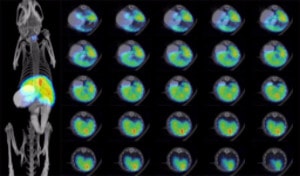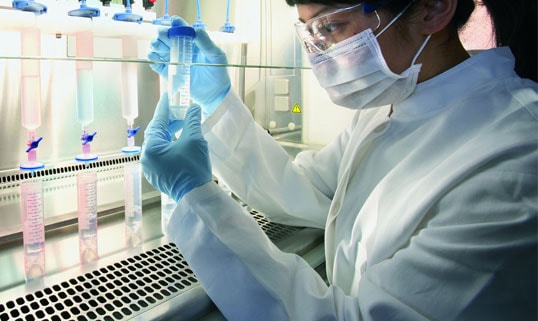CT26.WT-mNIS-Neo/Fluc-Puro
- Frozen / Standard (CL047-STAN) $ 2,100
Species: Mouse
Cell type: Colorectal Cancer
Transgenes: Murine sodium iodide symporter (mNIS) with neomycin resistance (Neo) for selection with G418 and firefly luciferase (Fluc) with puromycin resistance (Puro) for selection with puromycin
Media: DMEM, 10% FBS, 1% Pen/Strep, 0.4mg/mL G418, 3μg/mL puromycin
Description: CT26.WT-mNIS-Neo/Fluc-Puro is a polyclonal population of the murine colorectal carcinoma cell line CT26.WT (ATCC® CRL-2638™) transduced with 1) LV-mNIS-P2A-Neo (LV025) encoding the murine sodium iodide symporter (mNIS) cDNA under the spleen focus-forming virus (SFFV) promoter linked to the neomycin resistance gene (Neo) via a P2A cleavage peptide and 2) LV-Fluc-P2A-Puro (LV012) encoding firefly luciferase (Fluc) cDNA under the spleen focus-forming virus (SFFV) promoter linked to the puromycin resistance gene (Puro) via a P2A cleavage peptide.
The lentiviral vector used is a self-inactivating (SIN) vector in which the viral enhancer and promoter has been deleted. Transcription inactivation of the LTR in the SIN provirus increases biosafety by preventing mobilization by replication competent viruses and enables regulated expression of the genes from the internal promoters without cis-acting effects of the LTR (Miyoshi et al., J Virol. 1998).
Cell Line Authentication: Authentication of the parental CT26.WT cell line was performed by short tandem repeat (STR) profiling with 27 STR loci. STR profiling of CT26.WT cells are verified and there is no interspecies cross contamination detected.
Recommended uses:
In vitro: This is a high mNIS/Fluc expressing cell line suitable for use as a positive control cell line in iodine uptake assays and bioluminescence assays to verify NIS or luciferase expression respectively in your lentiviral transduced cells.
In vivo: CT26.WT cells form tumors post implantation into immunocompromised or syngenic Balb/c mice. The in vivo growth of these metastases can be monitored using noninvasive, high-resolution 3D PET/SPECT imaging or bioluminescent imaging with D-luciferin substrate.
References on NIS imaging:
1. Fruthwirth et al. A whole body dual modality radionuclide optical strategy for preclinical imaging of metastasis and heterogeneous treatment responses in different. microenvironments. J. Nucl. Med 2014. 55(4): 686-94.
2. Penheiter et al. The sodium iodide symporter (NIS) as an imaging reporter for gene, viral and cell-based therapies. Curr Gene Ther. 2012, 12(1):33-47.
Morphology: Low- and high-density cell morphology (200x)

NIS Function Assay (Iodine Uptake): Cells were incubated with 125I for 1h in the presence or absence of KClO4, an inhibitor of iodine uptake. Radioiodine concentrated within the cells was measured with a gamma counter.

Luciferase Assay: 104, 105, or 106 cells were placed in wells of a 96-well plate and 0.3 mg of d-luciferin was added to the indicated wells. The plate was immediately imaged using a Xenogen IVIS Spectrum.

Bioluminescent images showing growth of a subcutaneous CT26.WT-Fluc tumor in an athymic mouse

107 CT26.WT-Fluc-Neo cells (Imanis Life catalog #CL043) were injected subcutaneously into the right flanks of female NCR athymic mice. Mice were imaged at day 0 on the day of cell implantation and subsequently at days 7 and 11 using a Perkin Elmer IVIS® Spectrum system, at 10-15 minutes post intraperitoneal injection of D-luciferin at 150 mg/kg. Tumor size was measured using calipers. Data from a representative mouse (ID#5815) is shown.

